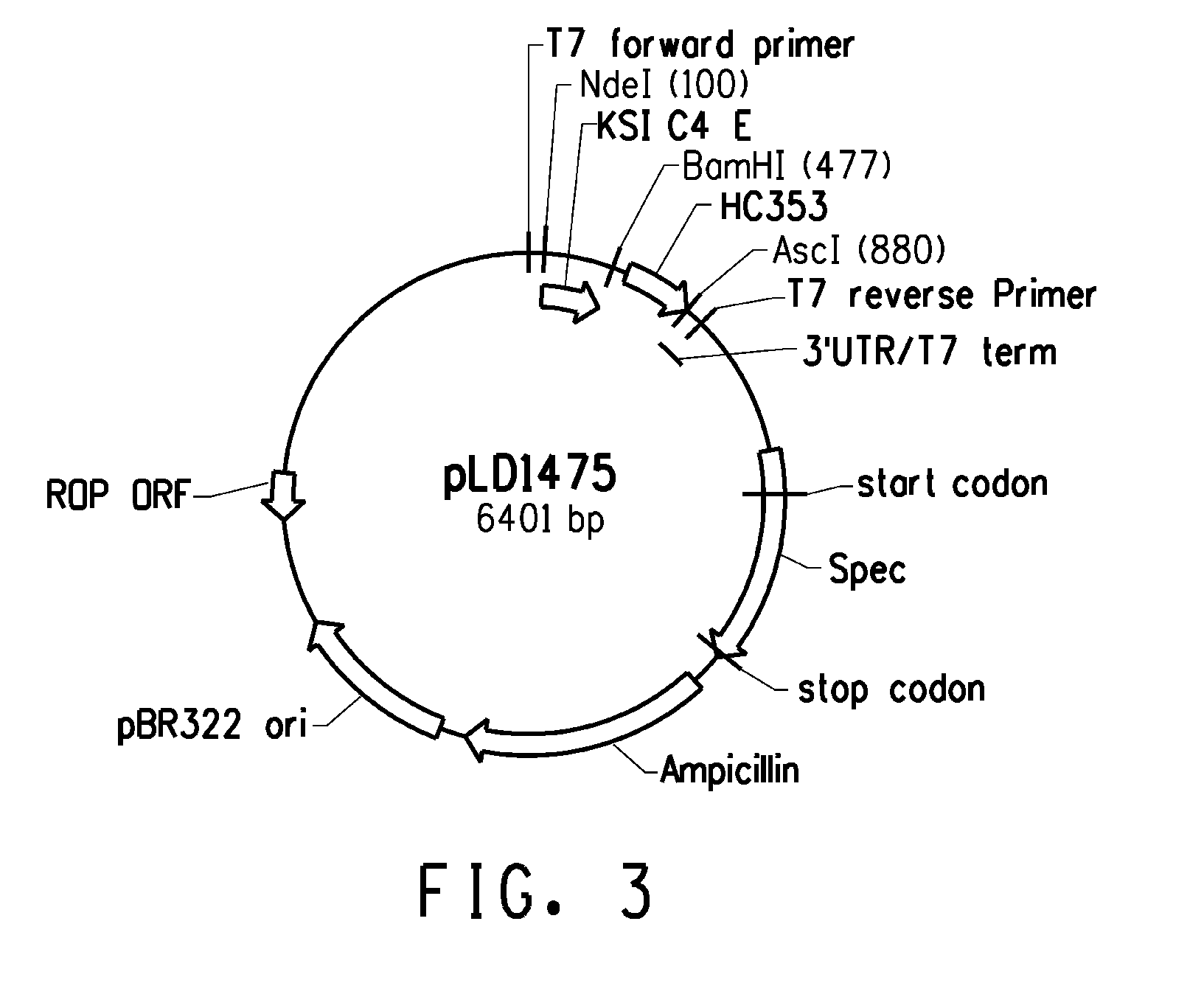Peptide linkers for effective multivalent peptide binding
a multivalent, peptide technology, applied in the direction of peptides, drug compositions, molecular structures, etc., can solve the problems of not providing targeted delivery or enhanced durability, difficult and expensive production of antibodies, and low affinity of peptides, so as to promote and enhance multivalent binding and high binding affinity. , the effect of enhancing the affinity
- Summary
- Abstract
- Description
- Claims
- Application Information
AI Technical Summary
Benefits of technology
Problems solved by technology
Method used
Image
Examples
example 1
Construction of a Combinatorial Modular Peptide Library
[0457]Peptide sequences with binding affinity for hair were discovered by phage display as described in U.S. Patent Application Publication NOs. 2007 / 0067924, 2008 / 0175798, 2007 / 0196305, 2006 / 0073111, 2007 / 0065387, and U.S. Patent 7,285,264). The binding affinities that characterize those sequences, as determined by half-saturation levels of biotinylated peptide binding to hair, are in the range between approximately 0.1 and 1 micromolar.
[0458]One strategy for improving those binding affinities makes use of avidity effects of multiple catenated binding sequences. For the maximal avidity effect, two binding sequences must be joined by a linker that is of an appropriate length to span the separation of the target binding epitopes on the surface of hair. Since no information is available regarding the spacing of epitopes or its regularity, flexibility in the linker is desirable. However, as argued by Mammen et al. (supra) entropic ...
example 2
Phaqe Display Biopanninq
[0465]The hair surface was prepared by bundling 50 strands of Caucasian 50% gray hair (International Hair Importers and Products, Bellerose, N.Y.; pre-cleaned with Neutrogena Clean Replenishing® Moisturizing shampoo Neutrogena Corp., Los Angeles, Calif.) with 3M (3M Corp., St. Paul, Minn.) surgical tape on one end. The bundled hairs were 1.5 cm in length and were either pre-blocked with 1% bovine serum albumin (BSA) at room temperature (˜21° C.) for 30 minutes or were not pre-blocked.
Round 1
[0466]The hair bundles were contacted with 1-mL of binding solution (1×108 pfu library) for 1 hour at room temperatures (˜21° C.) with gentle mixing followed by a 1 hour contact at 42° C. without mixing. The hair bundles were then washed twice with 1 mL of TBST buffer (0.5% TWEEN®-20) with gentle shaking at room temperature for 2 min each. The hair was then cut off and the 3M surgical tape was removed. Phage particles were eluted by either (1) adding 1 mL elution buffer (0...
example 3
Assay of Phage Binding to Hair
[0477]Phage particles recovered from panning (Example 2) were used to infect E. coli 10GF′ and transformants were purified by colony isolation. Purified phagemid clones were infected with helper phage VCSM13 and phage particles were isolated. Those purified phage clones were assayed for binding to hair by two methods.
a. Phage Titer
[0478]Six gray hair strands (1.5 cm long) were blocked with BSA (1 mg / mL) at room temperature (˜21° C.) for 30 min in 1.5 mL microfuge tubes, then washed twice with tris buffered saline (TBS). Phage particles were added in TBS plus 0.1% TWEEN®-20 and incubated at room temperature for 1 hour with gentle shaking. The hair was then washed 3 times with TBS plus 0.5% TWEEN®-20, and centrifuged briefly to remove excess liquid. E. coli 10GF′ (1 mL; OD600 nm=0.5) was added for 15 min. Aliquots were plated on selective plates and phagemid-containing colonies were counted (Table 4)
b. Phage ELISA
[0479]Gray hair (200 strands, 1.5 cm long ...
PUM
| Property | Measurement | Unit |
|---|---|---|
| Temperature | aaaaa | aaaaa |
| Temperature | aaaaa | aaaaa |
| Temperature | aaaaa | aaaaa |
Abstract
Description
Claims
Application Information
 Login to View More
Login to View More - R&D
- Intellectual Property
- Life Sciences
- Materials
- Tech Scout
- Unparalleled Data Quality
- Higher Quality Content
- 60% Fewer Hallucinations
Browse by: Latest US Patents, China's latest patents, Technical Efficacy Thesaurus, Application Domain, Technology Topic, Popular Technical Reports.
© 2025 PatSnap. All rights reserved.Legal|Privacy policy|Modern Slavery Act Transparency Statement|Sitemap|About US| Contact US: help@patsnap.com



